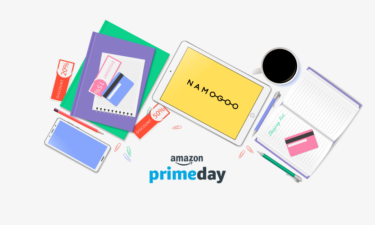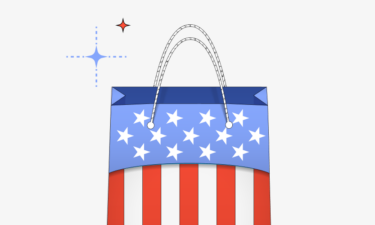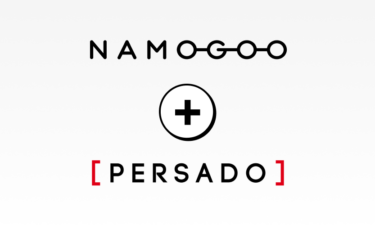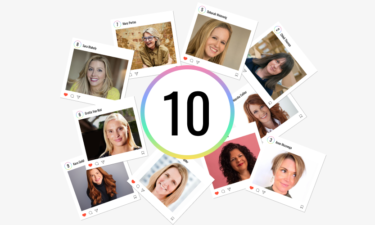Between the increasing difficulty brands are now experiencing with tracking and consumer data collection, and the rising customer acquisition costs, eCommerce teams are finding it more difficult than ever to see an ROI on their marketing efforts.
Even though most eCommerce brands report having all the tools they need available, there are major problems with the current operations and marketing landscape that online retailers have to battle, including:
- Siloed data: Each tool and platform marches to the beat of its own drum, which results in gaps that make marketing ineffective and often introduces difficulty in solid decision making.
- Blind spots in the customer journey: Trying to find opportunities for growth and scale is like searching for a needle in a haystack. Not only is it time-consuming, but it can also feel impossible to uncover insights because there’s no clear direction in which to look.
- Inability to take action in real-time: When teams do uncover valuable, actionable insights, it is usually not that easy to take immediate action, and when they are able to, it happens only after the opportunity has passed, rather than when it’s most relevant – in the moment as journeys are happening.
These pain points are exactly why an eCommerce operating system was born.
Customer Journey OS is the secret sauce to real-time customer experience management, so eCommerce teams can orchestrate, manage, and take action upon all journey data in the moment.
Customer Journey OS has Other Significant Benefits As Well
Customer Journey OS users have access to unique data points and high-value shopper segments that are not based on PII data but are far more valuable for eCommerce targeting.
These shopper-based enriched data points allow digital marketing and eCommerce managers to understand their shoppers’ lifestyles, shopping behavior, psychographics, the services that they use, and other non-personal data. The purpose? To actually help you personalize the journey for shoppers based on a deeper level of understanding of their personas.
In this guide, we’ll look at how an eCommerce operating system enables real-time segmentation and dynamic personalization to drive impact to every eCommerce KPI, from conversion through to customer lifetime value.
We’ll then present some effective strategies you can use to optimize every single step of the customer journey, from your ad targeting to the moment each visitor lands on your site, and beyond.
The Secret Revenue-Driving Power of Real-Time eCommerce Personalization
eCommerce personalization is an essential way to engage with shoppers, get them to buy, and ensure they keep coming back to your site.
But most businesses’ personalization efforts aren’t dynamic, which means that as soon as your visitors have finished interacting with your site, the conversation comes to an end, and you lose the opportunity to deliver them the most relevant experience in the moment.
That’s why eCommerce marketers have turned to dynamic personalization, which enables them to use real-time data to deliver the right message at the right time to the right customer to:
- Improve conversion rate
- Increase average order value
- Drive customer lifetime value
Using real-time segmentation and dynamic personalization, you can create more targeted omni-channel experiences, driving customers to convert faster and at higher price points, which in turn unlocks consistent, scalable revenue growth.
Here are some strategies off and onsite, we build for you to be utilizing dynamic personalization to drive impact to your most important eCommerce metrics.
How to Leverage Dynamic Segmentation to Improve eCommerce Conversion Rates
You can use Customer Journey OS to refine every step of the customer journey, from driving traffic that’s more likely to convert, to landing the sale.
Drive High-Intent Traffic That’s Primed for Conversion
The more traffic you bring to your eCommerce store the better, right?
Not so much.
Wasting resources on driving traffic to your site won’t do your team any good if that traffic is low-quality (and also, it’s pricey). The key to winning with traffic is to focus on attracting visitors who are primed for conversion.
The good news? This can be achieved through dynamic personalization and segmentation through the unique shopper segments Customer Journey OS offers.
First, start by building a separate campaign for high-intent shoppers (consumers with a high propensity to purchase from you).
Between the increasing difficulty brands are now experiencing with tracking and consumer data collection, and the rising customer acquisition costs, eCommerce teams are finding it more difficult than ever to see an ROI on their marketing efforts.
Even though most eCommerce brands report having all the tools they need available, there are major problems with the current operations and marketing landscape that online retailers have to battle, including:
- Serve ads to site visitors with a high purchase intent that didn’t convert on the first session with relevant retargeting ads.
- Target savvy shoppers with the tendency to buy often online (shoppers who are using shopping extensions) and tailor your ad copy for each type of shopping extension (cashback, coupon, Amazon assistant, etc).
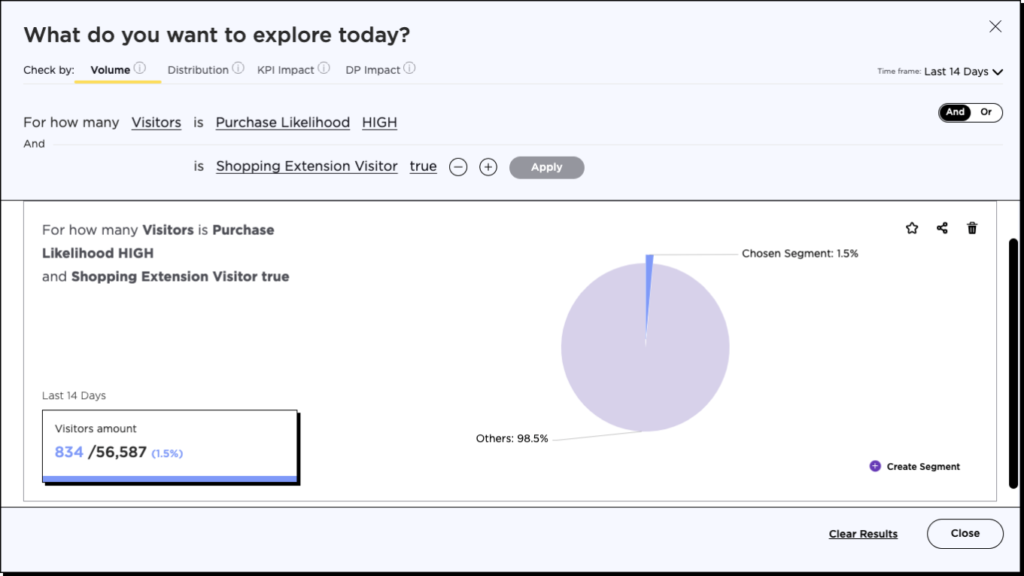
- Tailor your marketing campaigns by segmenting website visitors based on their average order value, and build lookalike audiences for the highest tiers.
- Identifying the customer cohorts with the highest customer lifetime value and building lookalike audiences of the most engaged customers to attract customers with the highest potential value.
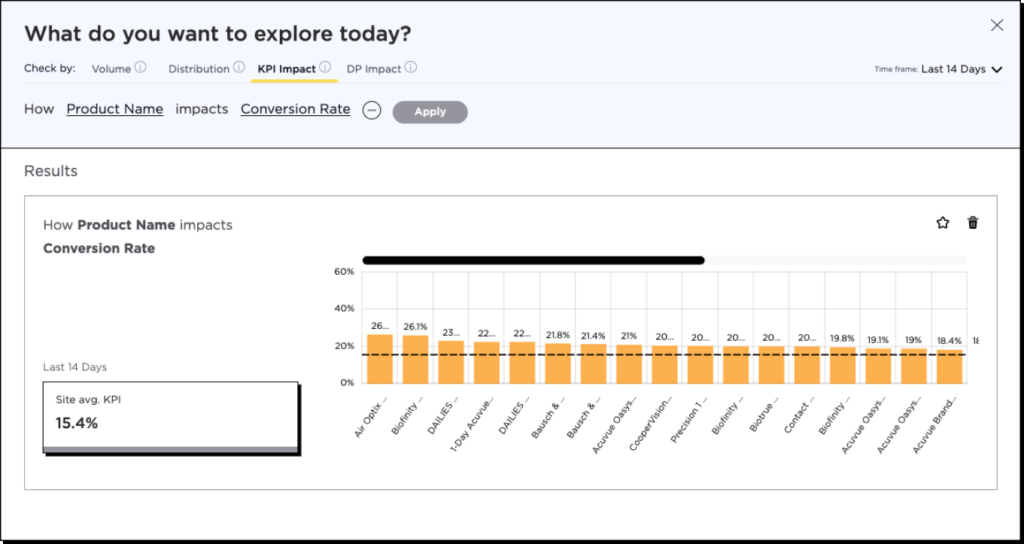
- Retarget visitors who started the checkout funnel and didn’t convert – new privacy regulations made this traditional targeting limited. Customer Journey OS enables you to push these visitor segments to your ad platforms (100% aligned with the new privacy regulations) to serve them dynamic ads tailored to their behavior on site.
- Improve the quality of traffic coming from your paid acquisition efforts by excluding bot traffic, visitors who use ad blockers, and low-intent shoppers from your ad targeting.
Personalize Your Ads to Meet the Needs of Different Types of Shoppers
Not all shoppers have a high intent to purchase. But that doesn’t mean you can’t get them to buy.
Here are a few shopper segments you can engage with to run more targeted campaigns.
First, start by building a dedicated campaign for shoppers that still need engagement with your brand to prime them for purchasing.
- Identify night vs day shoppers and build an ad set just for them. Pair this data point with other data points to really personalize for them (are they tech-savvy? What is their level of engagement? Have they added a product to their cart? Mind their level of buying intent)
- Adjust the content you create for low-intent users. Serve them UGC and reviews, educate them about your products, and target them with influencer campaigns to build trust and establish social proof.
- Respond to the weather conditions in your customer’s locations. Many consumers avoid shopping at physical stores when they are experiencing bad weather. Having a delivery right to your doorstep helps consumers feel connected even when they’re unable (or unmotivated) to leave the house. Offer free shipping and work with your creative and copy to match their state of mind.
- Retarget visitors who didn’t convert on their first session based on their engagement metrics – as mentioned, although privacy regulations limit traditional targeting options, Customer Journey OS lets you push segments to your ad platforms based on time on site, number of page views, engagement score, and other behavioral characteristics to serve them ads tailored to their behavior on site.
Golden Nugget: As it’s 100% PII-data-free, and privacy-proof, Customer Journey OS helps to bridge the gap between tracking problems and loss of data, which will also help you to increase ROAS and overall ROI.
Identify the Intent of Your Site Visitors and Tailor Your Strategy to Meet It
High Intent Visitors
Improving eCommerce conversions starts with driving the right visitors to your site. But if you stop there, you’ll be leaving conversions, revenue, and lifetime value on the table.
In order to shift consumers through the checkout funnel, first you need to identify the ones with high purchase intentions and lead them there. So the next step is to serve experiences to those visitors based on their customer intent.
- Identify visitors with high purchase intent and make sure they are not interrupted – avoid any pop-ups or other interstitials that might slow them on their way to purchase.
- Push reviews and User Generated Content above the fold as these visitors probably know your brand and users’ content can make that final purchase decision.
- Offer high-intent shoppers that show hesitations an Intent-Based Promotion that also knows when to pop, and give them that extra nudge at their onsite journey to complete the purchase.
Low Intent Visitors
Personalize your onsite experience to keep engaging and maximize the journeys of low-intent site visitors.
- Identify visitors who have a high probability of abandonment and trigger a chatbot to answer questions, handle objections, and provide support.
- Collect their emails and phone numbers to keep engagement and increase intent levels – offer low intent visitors a chance to win something valuable in exchange for their personal info, or push a tool in exchange for personal info such as: gift finder, product matcher, bundle creator.Guide users with low
- buying probability to landing pages with more education, social proof, and different value propositions to try and capture their interest.
Remove Friction to Conversion by Serving Tailored Website Experiences
Once the high-intent visitors start rolling in and you’re able to tailor the onsite experience for them and lower-intent visitors, there are other parameters you can adjust your onsite experience to remove friction and nurture more conversions.
Here are a few examples of ways to tailor the onsite experience for every shopper:
- Drive users with slow devices and low bandwidth to serve them lightweight landing pages and a streamlined checkout funnel. Remove heavy videos and rich media to help them navigate easily to the products they were interested in purchasing.
- Identify visitors who are more sensitive to privacy and only deliver a guest checkout, so these users won’t need to create an account. Build trust by excluding these users from being served information-gathering experiences like pop-ups and quizzes.
- Serve a basic version of your site to visitors who aren’t tech-savvy to reduce confusion and friction in the customer journey.
- Provide a cohesive experience by identifying the type of shopping extensions your site visitors are using (coupon? check back? Or even the exact extension) and adjust your onsite marketing and offers to talk to them in a language that moves them to convert.
Extract Value from Traffic That Hasn’t Yet Converted
No matter how targeted a customer journey you serve to each individual, some shoppers will leave without converting.
But that doesn’t mean you’ve lost them forever. You can Identify them with Customer Journey OS’ unique data points and:
- Personalize the experience they’re served when they return to your site to match the products and content they browsed during their initial session.
- Provide bargain hunters (a shopper segment under the “high discount recommended” data point) with bolder incentives across your remarketing and retargeting channels to turn them into customers.
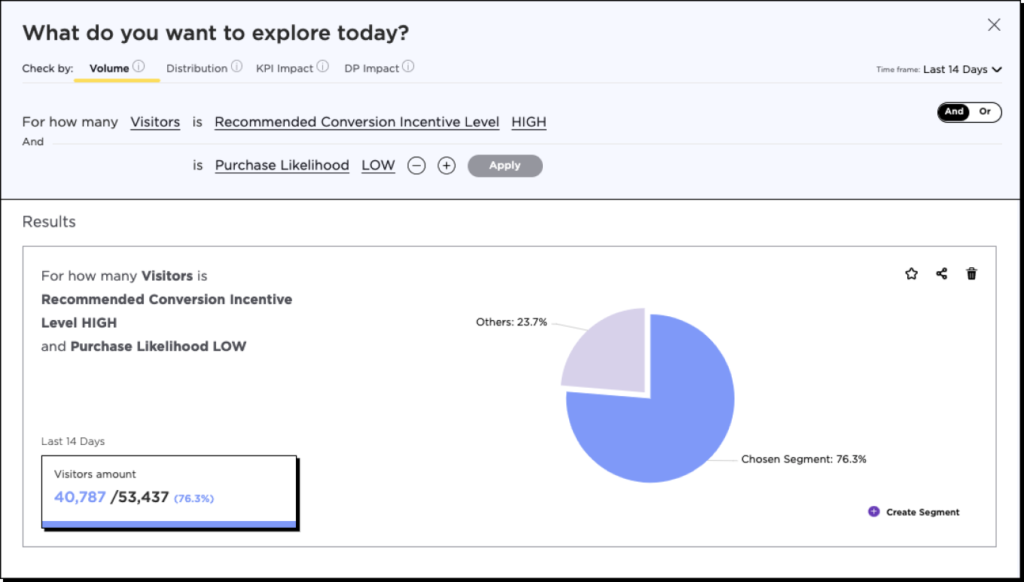
- Tailor your campaigns and cross-channel marketing with reduced offerings to “lower discount recommended” shopper segments and increase your margins.
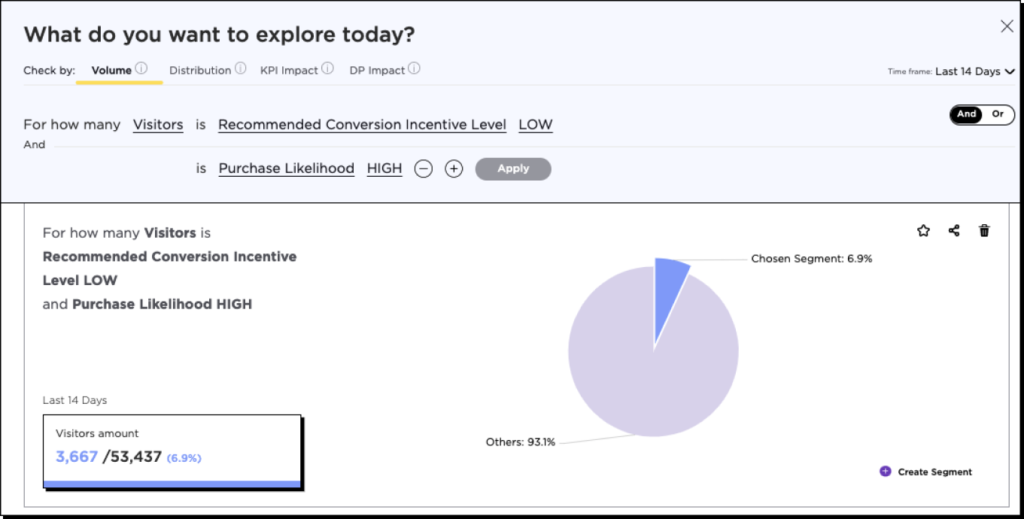
- Identify Amazon Assistant users and offer them promotions that resemble what they’re used to getting from Amazon – for example, fast and free delivery.
- Capture low-intent users’ email addresses or phone numbers and send them diverse content about your brand values, products, new collections, special sales and educational materials.
- Provide high-intent users with product suggestions that meet their onsite behavior.
- Send high-intent visitors SMS messages with time-limited sales on products they have seen but haven’t purchased, on related products, on bundles.
These strategies are bulletproof ways to optimize the customer experience and increase conversion rates. And when you pair them with the following strategies to drive average order value up, you get to have your cake and eat it, too.
How to Leverage Dynamic Segmentation to Increase Average Order Value
Your main objective as an online retailer is to drive revenue.
One of your strongest avenues for doing so is by improving your average order value (AOV), as every incremental dollar spent by customers represents another profit opportunity for you.
These six strategies will help to boost AOV and push each journey to its full potential.
Drive High-Value Traffic to Boost Cart Size
Maximizing your revenue starts with driving the right types of customers to your store. You can achieve this through
- Segmenting high-AOV customers and building lookalike audiences to improve the quality of traffic marketing campaigns bring to your site.
- Segmenting tech-savvy site visitors with lower price sensitivity and likelihood to achieve a higher cart value and offer them higher ticket items or bundle offerings.
Serve AOV-Boosting Incentives to Those Most Likely to Take Advantage of Them
After you’ve attracted visitors with the potential to become high-value customers to your site, leverage these next strategies to unlock their full potential.
- Showcase higher value products onsite to shoppers who are more likely to spend more, such as tech-savvy shoppers with lower price sensitivity (Customer Journey OS contains several data points to detect shoppers who are less price-sensitive).
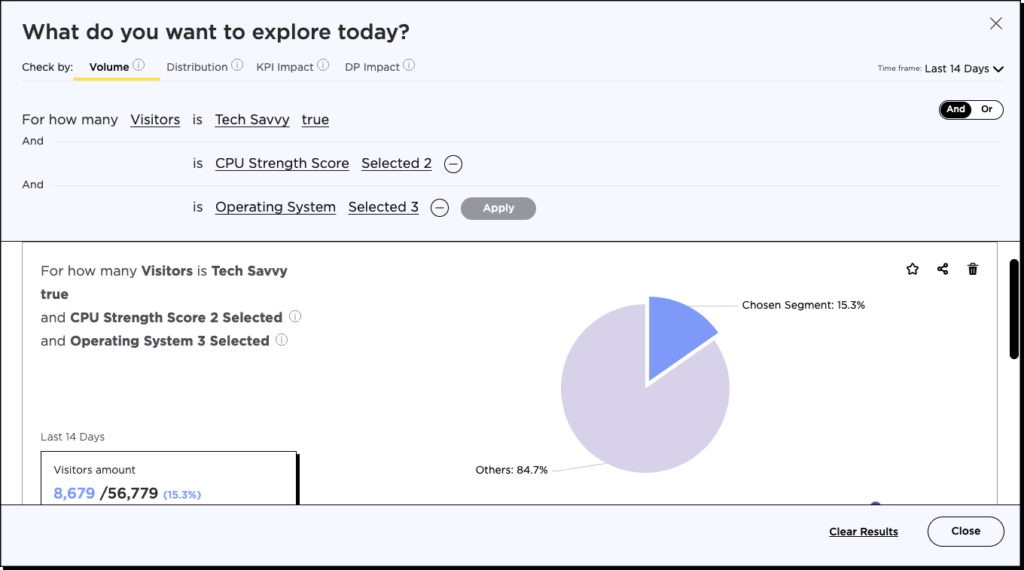
- Offer discounts on carts with a higher value than the visitor’s current cart value to encourage shoppers to add more items.
- Offer bundles to those with high likelihood of purchasing (high buying intent).
Customer Focused Marketing
- Offer “Buy More Get More” promotions (email, SMS, ads, onsite pop-up/banner) to returning customers based on their past purchases. This type of promotion performs better with customers who have already had previous experience with your brand.
- Offer your high-AOV customers relevant exclusive offers based on their purchasing behavior and history to attract higher-value purchases.
How to Leverage Dynamic Segmentation to Drive Customer Lifetime Value and Maximize Journeys’ Potential
Putting in all that effort to improve conversions and average order value through dynamic personalization only to attract customers that only buy once from your brand is a waste.
Most eCommerce teams would fail to reach their goals if it weren’t for repeat purchases – especially in today’s landscape of ever-rising customer acquisition costs. Brands need to nurture customer relationships to double down on customer lifetime value to build a sustainable, profitable channel.
By serving customized experiences to customers across all touchpoints in their shopper journey, you can nurture customer lifetime value to build a sustainable, profitable channel.
Below are some strategies for increasing repurchase rate and customer lifetime value through dynamic personalization.
Optimize for Customer Retention from the Very First Interaction
The process of building a base of loyal customers starts before you even land the conversion to begin with.
By attracting visitors that have the potential to turn into high-value customers, your team can set itself up for long-term success and maximize customer retention to its full potential. Some strategies to achieve this include:
- Analyze the channels and campaigns that attract the highest lifetime value shoppers and double down on those efforts.
- Building segments from your customers with the highest repurchase rates and creating lookalike audiences of these engaged customers to attract shoppers with the highest potential value.
- Offering personalized recommendations on the first conversion directing customers to order high-retention items to introduce shoppers to “sticky” products they’re most likely to re-order.
Transform Customer Experiences Proactively to Nail Customer Loyalty
- Help lingering customers who are inactive for a couple of minutes, and activate live chat to support and engage with these shoppers.
- Proactively offer customers who clicked on the “return policy” button or currently are viewing the policy page by offering different products as a replacement.
- Personalize the home page and onsite marketing messages to present your customers with the most relevant discount (based on the discount amount they used previously to purchase) on similar or complementary products to those they’ve previously purchased or viewed.
- Serve existing customers pop-ups with different value propositions than visitors who haven’t purchased yet. Offer incentives for referrals, or encourage joining your loyalty program.
- Identify customers with high purchase intentions and offer them surprise gifts tailored to their prior purchases with new products to test at special prices. Encourage eager customers to try more products. The more products they try, the greater the chance they will find one they love and return to purchase.
- Offer customers with high repurchase rates a pop-up with a subscription program.
Improve and Optimize Customer Marketing Activities to Build Relationships and Trust
Like all shoppers, not all customers that visited your site actually decided to make a purchase. But now you can use Customer Journey OS to enrich the data you have about your customers to drill deeper into their lifestyle, shopping habits and real-time motivations and needs. For example, you can:
- Identify customers with “high purchase intent” that haven’t yet converted and send them an SMS with a time-limited sale on items they’ve viewed.
- Identify the customers that need higher discounts and haven’t purchased, and only offer them an extra percentage off.
- Send customers that use coupon extensions an email or retarget them with a special campaign that gathers different types of coupon codes for different sales promotions. You can even open a dedicated section in your store for these coupon lovers.
- Remarket to customers who use ad blockers with personalized emails and SMS, avoiding wasting your budget retargeting them on ad platforms.
- Identify all customers who bounced due to page speed and accessibility and bring them to a lighter version of the landing page and checkout.




